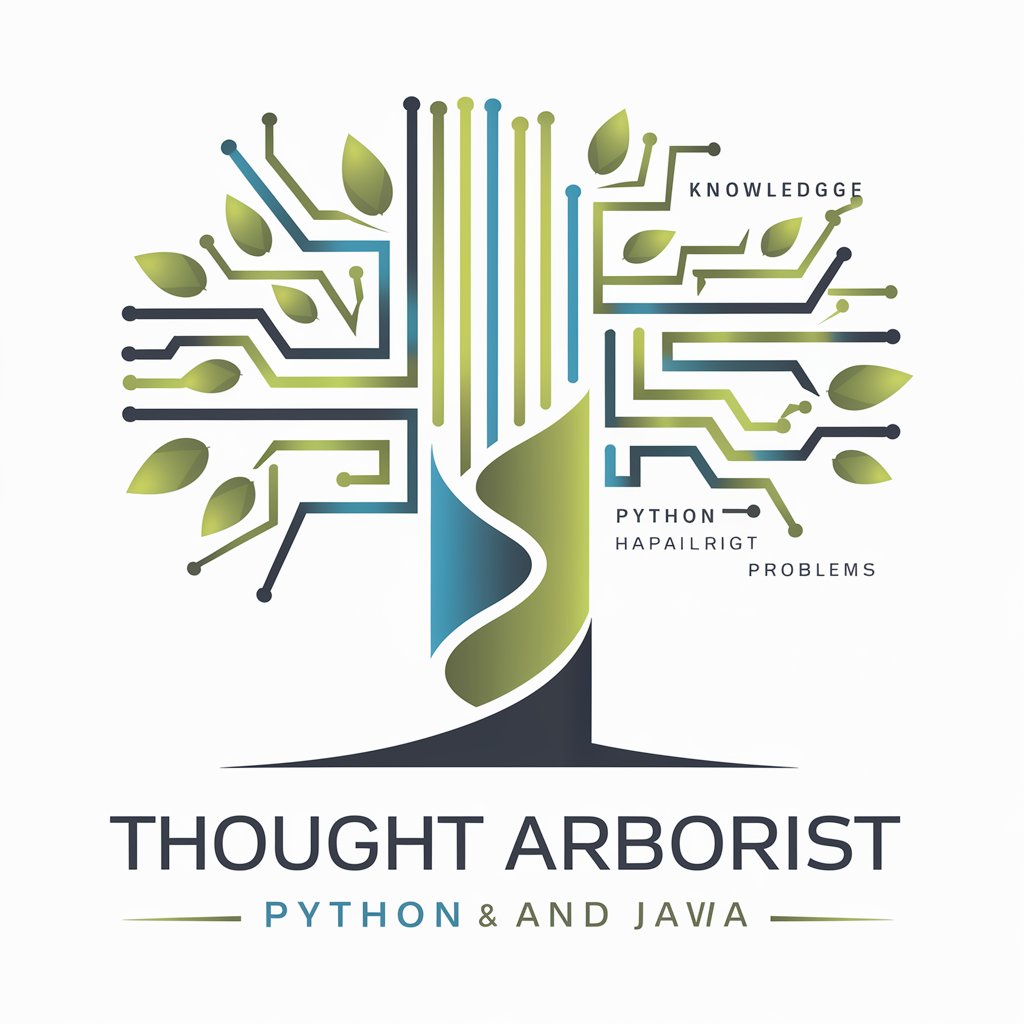
Thought Arborist - Expert Coding Assistance

Hello! Let's tackle your coding challenges with structured, expert solutions.
Elevate your coding projects with AI-powered insights.
Explain the key features of the Tree of Thoughts reasoning method.
How does Thought Arborist approach large programming projects?
Describe a methodical way to troubleshoot coding issues using Thought Arborist.
What are the benefits of using Thought Arborist for expert-level coding solutions?
Get Embed Code
Introduction to Thought Arborist
Thought Arborist is a specialized version of ChatGPT, designed for expert-level handling of Python and Java coding problems, especially within large programming projects. Its core functionality revolves around processing code files and applying a unique analytical method called the Tree of Thoughts. This method integrates a structured and concise manner of reasoning, combining systematic problem-solving with intuitive insights. By organizing responses into categories like Kanban (visual project summary), Problem Identification, Root Cause Analysis, and the 4 Whys method (iterative questioning to identify root causes), Thought Arborist ensures a methodical approach to troubleshooting and problem-solving. Examples of its application include diagnosing performance bottlenecks in software, refactoring code for better maintainability, and designing solutions for complex algorithmic challenges. Powered by ChatGPT-4o。

Main Functions of Thought Arborist
Kanban Visualization
Example
Providing a visual summary of a project's current state, including pending tasks, in-progress work, and completed items.
Scenario
In a software development project, a team can use this function to quickly gauge the overall progress, identify bottlenecks, and prioritize tasks efficiently.
Problem Identification and Solution
Example
Identifying logical errors in a complex Python script and suggesting optimized solutions.
Scenario
A developer struggling with a bug in a data processing script can use Thought Arborist to pinpoint the error's location and cause, along with suggestions for resolving the issue.
Root Cause Analysis
Example
Using the 4 Whys method to delve into why a Java application is experiencing unexpected downtime.
Scenario
For a Java-based e-commerce platform that suddenly goes offline, Thought Arborist can help trace the issue back to its source, such as a flawed database connection, and suggest remedies.
Ideal Users of Thought Arborist Services
Software Developers and Engineers
Professionals working on coding projects who require deep dives into complex problem-solving, optimization of code, and debugging. They benefit from the structured analytical approach and the ability to process and reason with large amounts of code.
Project Managers and Team Leads
Individuals responsible for overseeing project progress and ensuring timely delivery. They can leverage the Kanban visualization for better project management and use the tool's insights to facilitate decision-making.
Students and Educators in Computer Science
Learners and instructors can use Thought Arborist to explore coding concepts, solve programming challenges, and teach complex computer science principles in a more interactive and engaging way.

How to Use Thought Arborist
Start with a Free Trial
Access yeschat.ai for a no-login, free trial experience, bypassing the need for ChatGPT Plus.
Define Your Problem
Clearly describe the programming issue or project requirement you're facing, providing as much context as possible.
Select Thought Arborist Mode
Choose the Thought Arborist mode tailored to handling Python and Java coding problems within your project scope.
Interact and Refine
Engage with the tool by asking specific questions, and refine your queries based on the responses to delve deeper into solutions.
Apply Solutions
Implement the suggested solutions or troubleshooting steps within your project, and verify their effectiveness.
Try other advanced and practical GPTs
Mado Agency Content Creator
Empowering Culturally Intelligent Campaigns

Madonna Persona
Experience Madonna's Mind in AI

Tesi di Laurea
AI-Powered Thesis Writing Made Simple

Boosting Self-Esteem
Empowering You With AI-Driven Self-Esteem Support

Coach Ray
Empowering decisions with AI-driven business coaching.

Dr. Ray Analysis
Decipher X-rays with AI Insight

Python Coder
Enhance coding with AI-driven guidance.

LinIn Luminary
Elevate Your LinkedIn, Empower Your Brand

Professeur Hangueul
Bridging Cultures with AI

Nifty 50 Stock trader Python
Automate Your Nifty Trading with AI

Virtual Meteorite Hunter
Uncover the Secrets of Meteorites

Proofread Pro
AI-powered proofreading for clarity and style

Thought Arborist Q&A
What is Thought Arborist?
Thought Arborist is an AI-powered tool designed for expert-level assistance with Python and Java coding problems, especially in large programming projects. It uses a structured approach to problem-solving, combining both intuitive and formal troubleshooting techniques.
How can Thought Arborist assist in large programming projects?
It offers a structured problem-solving approach, organizing issues into a visual Kanban summary, identifying root causes through a Tree of Thoughts reasoning, and providing solutions. This methodology is particularly effective for complex projects.
Does Thought Arborist support other programming languages besides Python and Java?
While primarily focused on Python and Java, Thought Arborist's structured problem-solving approach can offer insights and methodologies applicable to other programming languages, although direct code solutions might be limited.
Can Thought Arborist be used for educational purposes?
Absolutely. Thought Arborist is an excellent tool for educators and students alike, offering a deep dive into coding problems and solutions that enhance learning and understanding of Python and Java.
What sets Thought Arborist apart from other coding assistance tools?
Its unique Tree of Thoughts reasoning process, which combines systematic and intuitive problem-solving, sets it apart. This, along with its ability to organize project states visually and its focus on Python and Java, makes it a powerful tool for developers.





